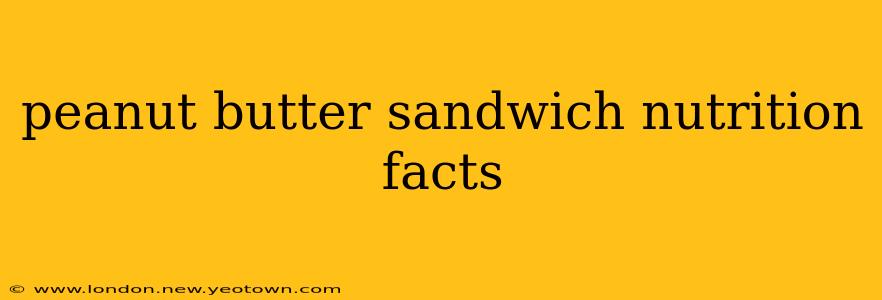The Humble Peanut Butter Sandwich: A Nutritional Powerhouse (or Pitfall?)
The peanut butter sandwich. A childhood staple, a lunchtime classic, a quick and easy snack. But beyond its simple construction, lies a surprisingly complex nutritional profile. This seemingly mundane food can be a source of essential nutrients or a contributor to weight gain, depending on the ingredients and portion size. Let's delve into the delicious details of this beloved sandwich and unpack its nutritional facts.
What are the nutritional facts of a peanut butter sandwich?
The nutritional facts of a peanut butter sandwich vary wildly depending on the type of bread, the amount of peanut butter used, and any additions like jelly or bananas. A typical sandwich, made with two slices of white bread and two tablespoons of creamy peanut butter, might contain approximately:
- Calories: 300-400
- Protein: 8-10 grams
- Fat: 15-20 grams (mostly unsaturated)
- Carbohydrates: 30-40 grams
- Fiber: 2-4 grams
Important Note: These are estimates. Always check the nutritional labels on your specific bread and peanut butter brands for the most accurate information.
Is a peanut butter sandwich healthy?
This is a question with a nuanced answer. A peanut butter sandwich can be a healthy part of a balanced diet, offering protein, healthy fats, and some fiber. However, it's crucial to be mindful of portion sizes and ingredient choices.
The "healthy" aspects:
- Protein: Peanut butter is a good source of protein, essential for building and repairing tissues.
- Healthy Fats: Peanut butter contains monounsaturated and polyunsaturated fats, which are beneficial for heart health.
- Fiber (depending on bread choice): Whole-wheat bread significantly increases the fiber content, promoting digestive health.
- Vitamins and Minerals: Peanut butter offers small amounts of various vitamins and minerals, including vitamin E, magnesium, and potassium.
The potential downsides:
- High in Calories and Fat: Overconsumption can lead to weight gain.
- High in Sugar (depending on bread and additions): Many breads and added ingredients like jelly significantly increase sugar content.
- Sodium: Check the sodium content of your bread and peanut butter, as high sodium intake can contribute to health problems.
- Allergies: Peanut allergies are common and severe; always exercise caution.
What kind of bread is best for a peanut butter sandwich?
Choosing the right bread is key to optimizing the nutritional value of your peanut butter sandwich. Opt for whole-wheat bread over white bread to boost fiber, vitamins, and minerals. Look for bread with minimal added sugars and sodium. Consider whole grain options like rye or oat bread for added nutritional benefits.
What are the benefits of eating a peanut butter sandwich?
Beyond the nutritional content, a peanut butter sandwich offers several benefits:
- Convenience: It's a quick and easy meal or snack, perfect for busy schedules.
- Affordability: Peanut butter and bread are relatively inexpensive food staples.
- Satisfying: The combination of protein and fat provides sustained energy and satiety.
How many calories are in a peanut butter sandwich?
As mentioned earlier, the calorie count varies greatly depending on the ingredients and portion sizes. A simple sandwich could range from 300 to 400 calories, but adding extra peanut butter, jelly, or using higher-calorie bread can significantly increase the calorie count. Always check the nutritional labels for precise calorie information.
Is peanut butter good for weight loss?
Peanut butter, in moderation, can be part of a weight loss diet. Its protein and fat content contribute to satiety, helping to curb cravings and reduce overall calorie intake. However, controlling portion sizes is crucial to avoid exceeding your daily calorie goals.
In conclusion, the peanut butter sandwich is more than just a simple lunch; it's a nutritional chameleon, capable of being both a healthy and less-than-healthy choice depending on your choices. By making mindful decisions about ingredients and portion sizes, you can enjoy this classic treat while reaping its nutritional benefits. Remember to always check the nutrition labels of your specific products for accurate information tailored to your selection.

